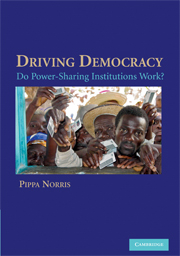Book contents
- Frontmatter
- Contents
- List of Tables
- List of Figures
- Preface and Acknowledgments
- PART I DO POWER-SHARING REGIMES WORK?
- PART II THE IMPACT OF POWER-SHARING INSTITUTIONS
- 5 Electoral Systems
- 6 Presidential and Parliamentary Executives
- 7 Federalism and Decentralization
- 8 The Fourth Estate
- PART III CONCLUSIONS
- Technical Appendix: Description of the Variables and Data Sources
- Notes
- Select Bibliography
- Index
6 - Presidential and Parliamentary Executives
Published online by Cambridge University Press: 05 September 2012
- Frontmatter
- Contents
- List of Tables
- List of Figures
- Preface and Acknowledgments
- PART I DO POWER-SHARING REGIMES WORK?
- PART II THE IMPACT OF POWER-SHARING INSTITUTIONS
- 5 Electoral Systems
- 6 Presidential and Parliamentary Executives
- 7 Federalism and Decentralization
- 8 The Fourth Estate
- PART III CONCLUSIONS
- Technical Appendix: Description of the Variables and Data Sources
- Notes
- Select Bibliography
- Index
Summary
The decision to adopt either a presidential or a parliamentary executive is a critical aspect of constitutional design. Considerable debate has surrounded which type is better for democratization. Reflecting upon developments in Latin America during the 1960s and 1970s, Juan Linz presented one of the most influential views, arguing that presidentialism presents substantial risks of political instability and even regime collapse. The reasons, Linz suggests, are that in electoral democracies with presidential regimes, both parliaments and presidents have rival sources of popular legitimacy and authority, making it difficult to resolve disputes. Presidents hold office for a fixed term, reducing flexibility. Presidential elections are winner take all, raising the stakes and generating weak incentives for the losers to accept the legitimacy of the outcome. And the fusion of the offices of head of state and head of the government may reduce restraints on political leaders arising from checks and balances. Scholars have commonly concurred with Linz's argument. Compared with parliamentary systems, for example, Riggs regards presidentialism as less capable of generating the representativeness and legitimacy required for the survival of democratic governance. Stepan and Skach compared patterns of democratic consolidation until the early-1990s and concluded that parliamentary executives were indeed more effective in this regard than presidentialism. They argue that parliamentary democracies are more likely to allow the largest party to implement their program, even in multiparty systems. Unpopular or scandal-ridden prime ministers can be replaced by other senior party leaders without destabilizing the whole regime.
- Type
- Chapter
- Information
- Driving DemocracyDo Power-Sharing Institutions Work?, pp. 132 - 156Publisher: Cambridge University PressPrint publication year: 2008



